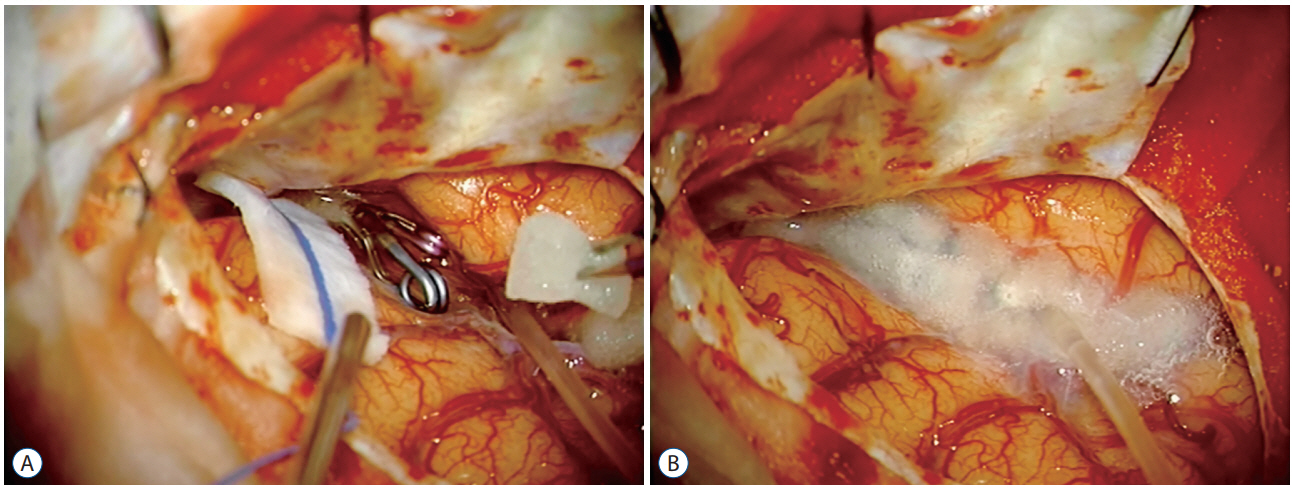J Korean Neurosurg Soc.
2018 Nov;61(6):761-766. 10.3340/jkns.2017.0242.
Modified Arachnoid Plasty Reduces Chronic Subdural Hematoma after Unruptured Aneurysm Clipping : Technical Note
- Affiliations
-
- 1Department of Neurosurgery, Samsung Medical Center, Sungkyunkwan University School of Medicine, Seoul, Korea. jsns.kim@samsung.com
- 2Department of Neurosurgery, Hana General Hospital, Cheongju, Korea.
- KMID: 2428119
- DOI: http://doi.org/10.3340/jkns.2017.0242
Abstract
OBJECTIVE
Chronic subdural hematoma (CSDH) is a rare complication of unruptured intracranial aneurysm (UIA) clipping surgery. To prevent postoperative CSDH by reducing subdural fluid collection, we applied the modified arachnoid plasty (MAP) during the UIA clipping surgery to seal the dissected arachnoid plane.
METHODS
This retrospective study included 286 patients enrolled from July 2012 to May 2015. We performed arachnoid plasty in all patients, with MAP used after June 17, 2014. Patients were divided into two groups (non-MAP vs. MAP), and by using uni- and multivariate analyses, baseline characteristics, and relationships with postoperative CSDH between the two groups were analyzed. The degree of preoperative brain atrophy was estimated using the bicaudate ratio (BCR) index.
RESULTS
Ten patients (3.5%) among 286 patients had postoperative CSDH after clipping. Nine (3.1%) were in the non-MAP group, and one (0.9%) was in the MAP group. The higher BCR index showed statistical significance with occurrence of postoperative CSDH in both uni- (p=0.018) and multivariate (p=0.012; odds ratio [OR], 8.547; 95% confidence interval [CI], 1.616-45.455) analyses. MAP was associated with a lower risk of postoperative CSDH (p=0.022; OR, 0.068; 95% CI, 0.007-0.683).
CONCLUSION
This study shows that the degree of preoperative brain atrophy is associated with an increased occurrence of CSDH after clipping and that MAP could help reduce the risk of postoperative CSDH after unruptured aneurysm clipping via a lateral supraorbital approach.
MeSH Terms
Figure
Cited by 1 articles
-
Arachnoid Plasty to Prevent and Reduce Chronic Subdural Hematoma after Clipping Surgery for Unruptured Intracranial Aneurysm : A Meta-Analysis
Kyoung Min Jang, Hyun Ho Choi, Taek Kyun Nam, Yong Sook Park, Jeong Taik Kwon
J Korean Neurosurg Soc. 2020;63(4):455-462. doi: 10.3340/jkns.2020.0036.
Reference
-
References
1. Abe J, Ichinose T, Terakawa Y, Tsuyuguchi N, Tsuruno T, Ohata K. Efficacy of arachnoid plasty with collagen sheets and fibrin glue: an in vitro experiment and a case review. Surg Neurol Int. 6:90. 2015.
Article2. Aylward EH, Schwartz J, Machlin S, Pearlson G. Bicaudate ratio as a measure of caudate volume on MR images. AJNR Am J Neuroradiol. 12:1217–1222. 1991.3. Cha KC, Hong SC, Kim JS. Comparison between lateral supraorbital approach and pterional approach in the surgical treatment of unruptured intracranial aneurysms. J Korean Neurosurg Soc. 51:334–337. 2012.
Article4. Hasturk AE, Basmaci M. Foreign body granuloma mimicking recurrent intracranial tumor: a very rare clinical entity. Acta Med Iran. 51:816–818. 2013.5. Inamasu J, Watabe T, Ganaha T, Yamada Y, Nakae S, Ohmi T, et al. Clinical characteristics and risk factors of chronic subdural haematoma associated with clipping of unruptured cerebral aneurysms. J Clin Neurosci. 20:1095–1098. 2013.
Article6. Kanazawa R, Sato S, Iwamoto N, Teramoto A. Allergic reaction following arachnoid plasty with a fibrin sealant. Neurol Med Chir (Tokyo). 50:608–610. 2010.7. Kothbauer KF, Jallo GI, Siffert J, Jimenez E, Allen JC, Epstein FJ. Foreign body reaction to hemostatic materials mimicking recurrent brain tumor. report of three cases. J Neurosurg. 95:503–506. 2001.
Article8. Lee WJ, Jo KI, Yeon JY, Hong SC, Kim JS. Incidence and risk factors of chronic subdural hematoma after surgical clipping for unruptured anterior circulation aneurysms. J Korean Neurosurg Soc. 57:271–275. 2015.
Article9. Mino Y, Hirashima Y, Hamada H, Masuoka T, Yamatani K, Takeda S, et al. Effect of arachnoid plasty using fibrin glue membrane after clipping of ruptured aneurysm on the occurrence of complications and outcome in the elderly patients. Acta Neurochir (Wien). 148:627–631. discussion 631. 2006.
Article10. Mori K, Maeda M. Risk factors for the occurrence of chronic subdural haematomas after neurosurgical procedures. Acta Neurochir (Wien). 145:533–539. discussion 539-540. 2003.
Article11. Ohno T, Iihara K, Takahashi JC, Nakajima N, Satow T, Hishikawa T, et al. Incidence and risk factors of chronic subdural hematoma after aneurysmal clipping. World Neurosurg. 80:534–537. 2013.
Article12. Quintana LM. Chronic subdural hematoma after neurosurgical procedures. World Neurosurg. 80:482–483. 2013.
Article13. Sim YW, Min KS, Lee MS, Kim YG, Kim DH. Recent changes in risk factors of chronic subdural hematoma. J Korean Neurosurg Soc. 52:234–239. 2012.
Article14. Takahashi Y, Ohkura A, Sugita Y, Sugita S, Miyagi J, Shigemori M. Postoperative chronic subdural hematoma following craniotomy--four case reports. Neurol Med Chir (Tokyo). 35:78–81. 1995.15. Yagi K, Irie S, Inagaki T, Ishii Y, Saito O, Lee T, et al. Intraoperative arachnoid plasty has possibility to prevent chronic subdural hematoma after surgery for unruptured cerebral aneurysms. Neurol Med Chir (Tokyo). 55:493–497. 2015.
Article16. Yoshimoto T, Houkin K, Ishikawa T, Abe H. Arachnoid membrane closure. prevention of postoperative cerebrospinal fluid leakage. Surg Neurol. 52:68–71. discussion 71-72. 1999.17. Yoshimoto Y, Wakai S, Hamano M. External hydrocephalus after aneurysm surgery: paradoxical response to ventricular shunting. J Neurosurg. 88:485–489. 1998.
Article
- Full Text Links
- Actions
-
Cited
- CITED
-
- Close
- Share
- Similar articles
-
- Arachnoid Plasty to Prevent and Reduce Chronic Subdural Hematoma after Clipping Surgery for Unruptured Intracranial Aneurysm : A Meta-Analysis
- Treatment of Chronic Subdural Hematoma with Arachnoid Cyst
- Incidence and Risk Factors of Chronic Subdural Hematoma after Surgical Clipping for Unruptured Anterior Circulation Aneurysms
- Arachnoid Cyst with Spontaneous Intracystic Hemorrhage and Chronic Subdural Hematoma
- Two Cases of Arachnoid Cyst of the Middle Cranial Fossa with Chronic Subdural Hematoma



